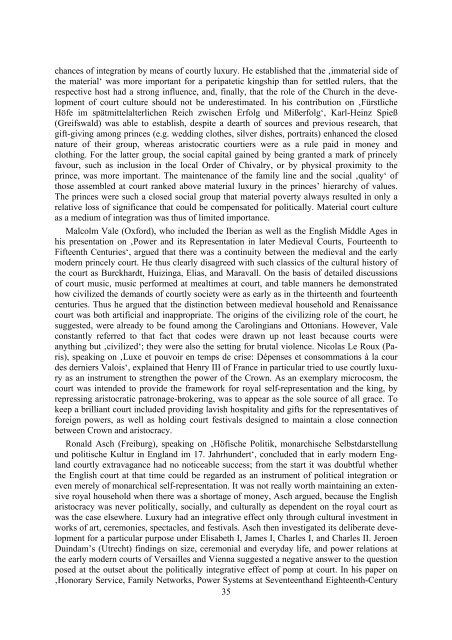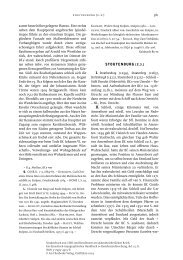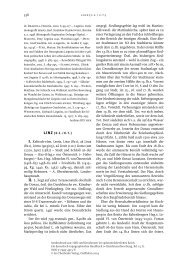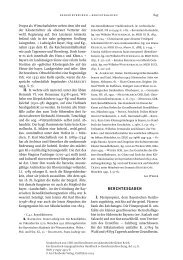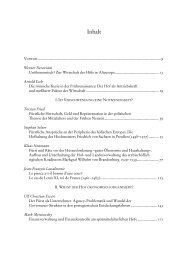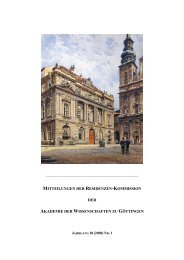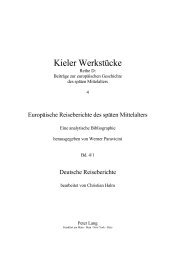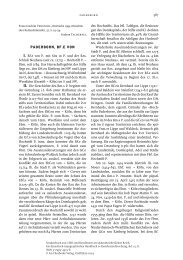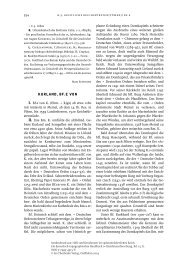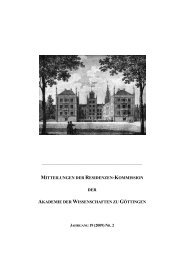MITTEILUNGEN DER RESIDENZEN-KOMMISSION DER ...
MITTEILUNGEN DER RESIDENZEN-KOMMISSION DER ...
MITTEILUNGEN DER RESIDENZEN-KOMMISSION DER ...
Sie wollen auch ein ePaper? Erhöhen Sie die Reichweite Ihrer Titel.
YUMPU macht aus Druck-PDFs automatisch weboptimierte ePaper, die Google liebt.
chances of integration by means of courtly luxury. He established that the ‚immaterial side of<br />
the material‘ was more important for a peripatetic kingship than for settled rulers, that the<br />
respective host had a strong influence, and, finally, that the role of the Church in the development<br />
of court culture should not be underestimated. In his contribution on ‚Fürstliche<br />
Höfe im spätmittelalterlichen Reich zwischen Erfolg und Mißerfolg‘, Karl-Heinz Spieß<br />
(Greifswald) was able to establish, despite a dearth of sources and previous research, that<br />
gift-giving among princes (e.g. wedding clothes, silver dishes, portraits) enhanced the closed<br />
nature of their group, whereas aristocratic courtiers were as a rule paid in money and<br />
clothing. For the latter group, the social capital gained by being granted a mark of princely<br />
favour, such as inclusion in the local Order of Chivalry, or by physical proximity to the<br />
prince, was more important. The maintenance of the family line and the social ‚quality‘ of<br />
those assembled at court ranked above material luxury in the princes’ hierarchy of values.<br />
The princes were such a closed social group that material poverty always resulted in only a<br />
relative loss of significance that could be compensated for politically. Material court culture<br />
as a medium of integration was thus of limited importance.<br />
Malcolm Vale (Oxford), who included the Iberian as well as the English Middle Ages in<br />
his presentation on ‚Power and its Representation in later Medieval Courts, Fourteenth to<br />
Fifteenth Centuries‘, argued that there was a continuity between the medieval and the early<br />
modern princely court. He thus clearly disagreed with such classics of the cultural history of<br />
the court as Burckhardt, Huizinga, Elias, and Maravall. On the basis of detailed discussions<br />
of court music, music performed at mealtimes at court, and table manners he demonstrated<br />
how civilized the demands of courtly society were as early as in the thirteenth and fourteenth<br />
centuries. Thus he argued that the distinction between medieval household and Renaissance<br />
court was both artificial and inappropriate. The origins of the civilizing role of the court, he<br />
suggested, were already to be found among the Carolingians and Ottonians. However, Vale<br />
constantly referred to that fact that codes were drawn up not least because courts were<br />
anything but ‚civilized‘; they were also the setting for brutal violence. Nicolas Le Roux (Paris),<br />
speaking on ‚Luxe et pouvoir en temps de crise: Dépenses et consommations à la cour<br />
des derniers Valois‘, explained that Henry III of France in particular tried to use courtly luxury<br />
as an instrument to strengthen the power of the Crown. As an exemplary microcosm, the<br />
court was intended to provide the framework for royal self-representation and the king, by<br />
repressing aristocratic patronage-brokering, was to appear as the sole source of all grace. To<br />
keep a brilliant court included providing lavish hospitality and gifts for the representatives of<br />
foreign powers, as well as holding court festivals designed to maintain a close connection<br />
between Crown and aristocracy.<br />
Ronald Asch (Freiburg), speaking on ‚Höfische Politik, monarchische Selbstdarstellung<br />
und politische Kultur in England im 17. Jahrhundert‘, concluded that in early modern England<br />
courtly extravagance had no noticeable success; from the start it was doubtful whether<br />
the English court at that time could be regarded as an instrument of political integration or<br />
even merely of monarchical self-representation. It was not really worth maintaining an extensive<br />
royal household when there was a shortage of money, Asch argued, because the English<br />
aristocracy was never politically, socially, and culturally as dependent on the royal court as<br />
was the case elsewhere. Luxury had an integrative effect only through cultural investment in<br />
works of art, ceremonies, spectacles, and festivals. Asch then investigated its deliberate development<br />
for a particular purpose under Elisabeth I, James I, Charles I, and Charles II. Jeroen<br />
Duindam’s (Utrecht) findings on size, ceremonial and everyday life, and power relations at<br />
the early modern courts of Versailles and Vienna suggested a negative answer to the question<br />
posed at the outset about the politically integrative effect of pomp at court. In his paper on<br />
‚Honorary Service, Family Networks, Power Systems at Seventeenthand Eighteenth-Century<br />
35


